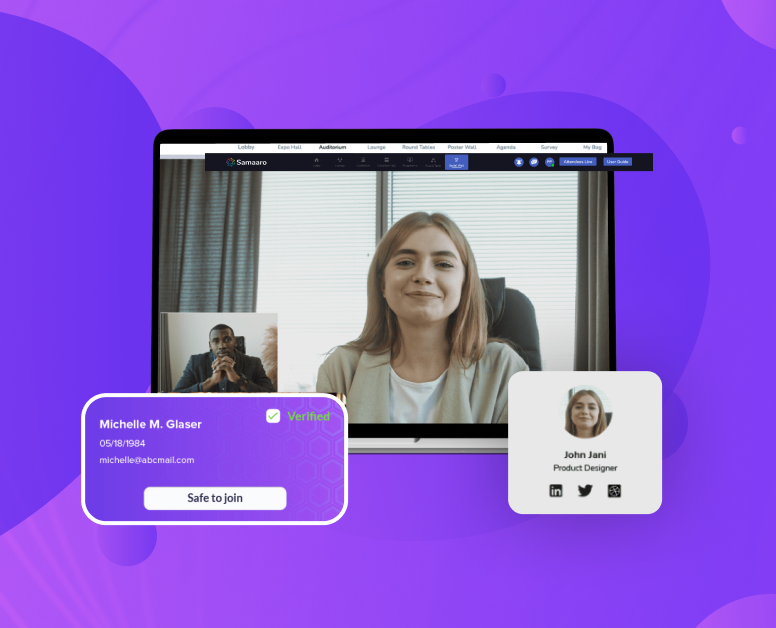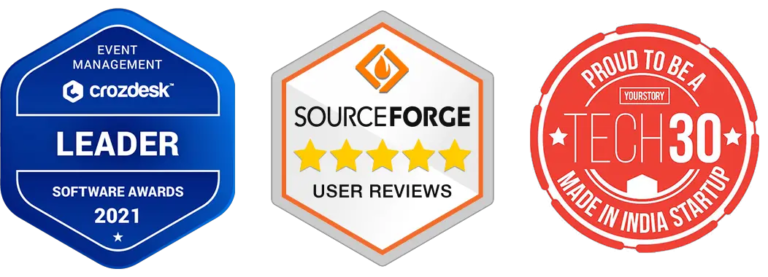Samaaro + Your CRM: Zero Integration Fee for Annual Sign-Ups Until 30 June, 2025
- 00Days
- 00Hrs
- 00Min

In the age of social distancing, virtual events have become the new norm, and they’re not just a passing fad. These digital gatherings offer businesses a chance to go beyond the limits of brick-and-mortar venues and connect with audiences from all over the world. With the rise of cutting-edge technology, virtual events have become more engaging and interactive than ever before. So, if you’re looking for a way to spice up your relationship with customers and spice up your events, consider giving the virtual world a try!
In this article, we’ll provide a complete guide to virtual events, using Samaaro’s virtual event platform as an example, covering everything from choosing the right platform to marketing your event, and how technology can enhance the virtual event experience.
A virtual event is a type of event where attendees participate and experience the event and its content through online means instead of being physically present at a physical location. It involves the use of technology such as live streaming, video conferencing, and other web-based tools to facilitate engagement between participants and speakers. Virtual events can include webinars, online conferences, digital trade shows, and other similar activities that are conducted in a virtual environment. They are becoming increasingly popular because of the convenience they offer and the growing trend towards remote work and distributed teams.

Virtual events can complement and expand your overall event program, which includes events you organize, attend, and internal company events. It’s worth noting that virtual events are not intended to replace other types of events but rather to offer a new dimension to your overall program. Below are the 7 kinds of virtual events and some important points about these events.
Webinars
Virtual Conferences
Internal Hybrid Events
External Hybrid Events
Virtual Exhibitions
Virtual Seminars
Virtual Trade Shows
In today’s fast-paced and ever-changing world, hosting virtual events has become increasingly popular due to the convenience and accessibility they offer. Virtual events can provide a way to connect with a global audience, reduce costs, and offer flexibility for attendees to participate from anywhere. Below are some of the key reasons why hosting a virtual event may be a smart decision for your organization.

Planning a virtual event can seem daunting, but the process is quite like planning an in-person event. As with any event, it is important to put yourself in the attendees’ shoes and consider their experience. You don’t want to bore them with long stretches of content or neglect their need for engagement and interaction. By following standard planning tips and tricks, you can create and execute a successful virtual event.
Define Your Objectives
The first step in event planning is to define the purpose and goals of the event. Event planners need to identify the target audience, the type of event, and the objectives that need to be achieved using technology. For example, if the event is a conference, the objectives may include providing attendees with access to high-quality presentations, networking opportunities, and the ability to interact with the speakers and other attendees.
Here are some questions you should be asking before planning any virtual event.
Defining your objectives will help you make informed decisions throughout the planning process.
Choose the Right Platform
The most crucial step in hosting a successful virtual event is choosing the right platform. Samaaro’s virtual event platform offers a wide range of features and customization options to make your event stand out. Some of the features include:
Consider factors such as the number of attendees, your budget, and the type of event you’re hosting when choosing a platform.
Set a Date and Time
Once you’ve chosen your platform, it’s time to set a date and time for your event. Consider your target audience’s availability and choose a time that is convenient for them. Avoid scheduling your event during holidays or peak business hours.
Create an Agenda
Creating a clear and concise agenda for your virtual event is crucial. This will help you stay organized and ensure that your event runs smoothly. It will also help your attendees know what to expect from the event. Samaaro’s virtual event platform allows you to create a customized agenda for your event, including details such as the event’s start and end time, speakers, topics, and any interactive elements such as polls or Q&A sessions.
Choose Your Speakers
The success of your virtual event largely depends on the quality of your speakers. Choose speakers who are knowledgeable and engaging and who can offer valuable insights to your attendees. Samaaro’s virtual event platform allows you to invite and manage speakers for your event, making it easy to collaborate and ensure that your event’s content is top-notch.
Promote Your Event
Promoting your virtual event is crucial to ensure that you get the attendance you need. Use social media platforms, email marketing, and your website to promote your event to your target audience. Samaaro’s virtual event platform offers marketing tools like customizable email invites, registration pages, and social media sharing options to help you get the word out about your event.
Engage Your Audience
Engaging your audience during your virtual event is crucial to keep them interested and invested in your content. Use interactive elements such as polls, Q&A sessions, and breakout rooms to keep your attendees engaged and encourage participation. Samaaro’s virtual event platform offers a variety of interactive tools to keep your attendees engaged and ensure that your event is a success.
Follow Up with Attendees
Following up with attendees after your virtual event is crucial to maintain their interest and build lasting relationships. Send a thank-you email or survey to your attendees, asking for feedback and offering additional resources or information. Samaaro’s virtual event platform offers a post-event survey feature that allows you to gather feedback and insights from your attendees, helping you improve your future events.

To host successful virtual events, relying solely on video conferencing tools isn’t enough. A comprehensive event technology platform is essential for promoting, executing, and managing virtual events. Several important pieces of event tech are critical to utilize when hosting virtual events.
In conclusion, virtual events have become increasingly popular due to the convenience, accessibility, and flexibility they offer. They provide a way to connect with a global audience, reduce costs, and offer valuable data and analytics on attendee engagement and behavior. Hosting a successful virtual event requires careful planning and execution, and the use of the right technology. By following the tips and tricks provided in this guide, including choosing the right platform, marketing your event, and enhancing the virtual experience with technology, you can create a successful virtual event that engages your audience and meets your organization’s objectives. So, if you’re looking for a way to spice up your events and relationship with customers, consider giving the virtual world a try!
Samaaro’s virtual event platform offers a wide range of features and customization options to make your virtual event stand out. With its interactive elements, custom branding options, and detailed analytics, Samaaro’s platform can help you engage your audience, create a memorable experience, and build lasting relationships with your customers.
As virtual events continue to grow in popularity, businesses need to embrace the latest technologies and platforms to stay ahead of the curve. By following the tips outlined in this guide and leveraging the power of Samaaro’s virtual event platform, you can host a successful virtual event that drives engagement, builds brand awareness, and delivers value to your attendees.
Q: What is a virtual event?
A: It is a type of event where attendees participate and experience the event and its content through online means instead of being physically present at a physical location. It involves the use of technology such as live streaming, video conferencing, and other web-based tools to facilitate engagement between participants and speakers.
Q: What are the types of virtual events?
A: There are seven types namely webinars, virtual conferences, internal hybrid events, external hybrid events, virtual exhibitions, virtual seminars, and virtual trade shows.
Q: Why host a virtual event?
A: Because they offer several benefits such as accessibility, cost savings, flexibility, data and analytics, and sustainability. They can provide a way to connect with a global audience, reduce costs, and offer flexibility for attendees to participate from anywhere.
Q: How do you plan a virtual event?
A: Planning a virtual event is similar to planning an in-person event. It is important to define the objectives, choose the right platform, plan the content and schedule, promote the event, engage attendees, and measure success. The key is to use event technology to support the objectives of the event and enhance attendee experience.
Q: What is the virtual event technology checklist?
A: The virtual event technology checklist includes choosing the right virtual event platform, audio and visual equipment, reliable internet connection, engagement tools, and backup plans. It is important to test the technology beforehand to ensure a smooth experience for attendees.

Samaaro is an all-in-one event technology company that offers a comprehensive suite of event management solutions to help event organisers streamline operations, boost attendee engagement and maximise ROI of their events.


© 2025 — Samaaro. All Rights Reserved.